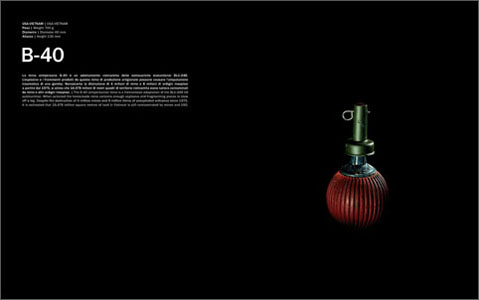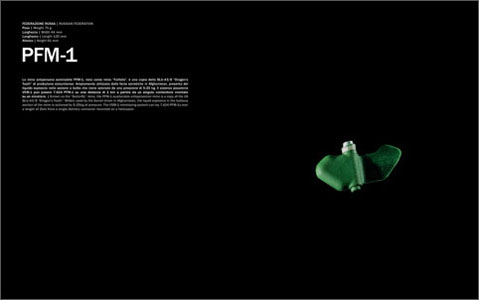Descrizione
[:it]Martin Parr
[..One of photography’s great strength is its ability to catalogue and record the world in which we live. The simplicity and clarity that photography offers has both commercial and artistic possibilities. In more recent years there has been a trend towards documentary photographers isolating one particular aspect of society and exploring this in great detail. Dallaporta presents the most chilling example of this genre by photographing antipersonnel landmines. These strange ugly objects also have a certain disturbing beauty to them. We hear about the damage that landmines inflict on innocent victims long after the purpose of their planting has lapsed. They of course are hidden underground before exploding. I had never seen a landmine in real life or in a photograph until discovering Dallaporta’s images. It was a revelation. We now learn that hundreds of types of landmines exist and a variety of appearance, shape and design is incredible. Because Dallaporta has photographed these objects in the way an advertising photographer might render a shampoo bottle, he glorifies these objects and yet appears totally neutral in his approach. It is most a clever trick, so much so that we hardly notice he has done it..]
Raphaёl Dallaporta was born in 1980. Lives and work in Paris. Graduated in 2002 from Les Gobelins, Paris. Awarded a year’s residence in 2002 at Fabrica, Italy. His series “The Ladies of Noyant” and “Caravans” was presented in May 2003 as a part of FotoGrafia, the Rome International photography festival, curated by Marco Delogu, at “il Segno” gallery. His “Antipersonnel” project was selected for the “Rencontres d’Arles” 2004 by Martin Parr (curator of the 35th edition) and exhibited in the St-Blaise chapel. His photographs can be found in collections including the Fond National d’Art Contemporain, France, and the Maison Européenne de la Photographie, France.[:en]Martin Parr
[..One of photography’s great strength is its ability to catalogue and record the world in which we live. The simplicity and clarity that photography offers has both commercial and artistic possibilities. In more recent years there has been a trend towards documentary photographers isolating one particular aspect of society and exploring this in great detail. Dallaporta presents the most chilling example of this genre by photographing antipersonnel landmines. These strange ugly objects also have a certain disturbing beauty to them. We hear about the damage that landmines inflict on innocent victims long after the purpose of their planting has lapsed. They of course are hidden underground before exploding. I had never seen a landmine in real life or in a photograph until discovering Dallaporta’s images. It was a revelation. We now learn that hundreds of types of landmines exist and a variety of appearance, shape and design is incredible. Because Dallaporta has photographed these objects in the way an advertising photographer might render a shampoo bottle, he glorifies these objects and yet appears totally neutral in his approach. It is most a clever trick, so much so that we hardly notice he has done it..]
Raphaёl Dallaporta was born in 1980. Lives and work in Paris. Graduated in 2002 from Les Gobelins, Paris. Awarded a year’s residence in 2002 at Fabrica, Italy. His series “The Ladies of Noyant” and “Caravans” was presented in May 2003 as a part of FotoGrafia, the Rome International photography festival, curated by Marco Delogu, at “il Segno” gallery. His “Antipersonnel” project was selected for the “Rencontres d’Arles” 2004 by Martin Parr (curator of the 35th edition) and exhibited in the St-Blaise chapel. His photographs can be found in collections including the Fond National d’Art Contemporain, France, and the Maison Européenne de la Photographie, France.[:]















